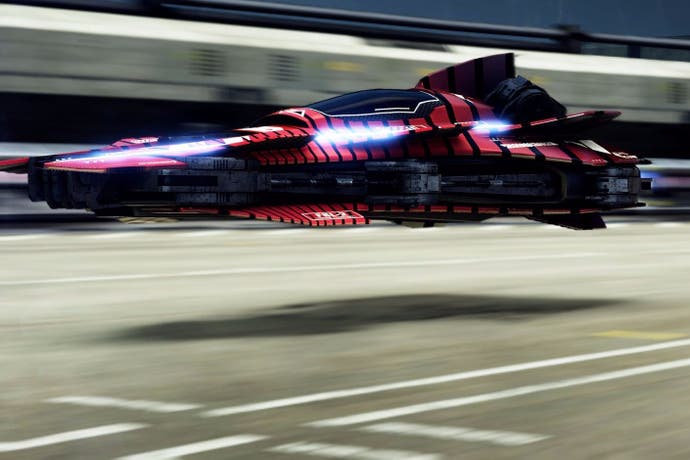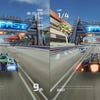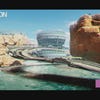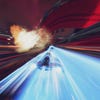Digital Foundry vs Fast Racing Neo
Superb gameplay wrapped up in a Wii U tech showcase.
With the closure of Studio Liverpool three years ago and the lack of a new F-Zero title from Nintendo, it's been a rough few years for fans of futuristic racing games. Thankfully, 2015 is closing out in style with the release of Fast Racing Neo on Wii U. With this title, developer Shin'en demonstrates its technical prowess with some of the most impressive visuals we've seen on Nintendo's console . It's an example of old-school graphics programming at its finest, where smart optimisations and clever tricks produce results exceeding typical expectations for the platform. With so many smaller teams building games using off the shelf middleware these days, it's a rare treat indeed to experience such an impressive-looking game engineered entirely in-house.
Evidence of its technical prowess can be seen right from the download screen - Fast Racing Neo weighs in at meagre 556MB. This comes as no surprise considering Shin'en's roots in the demo scene as Abyss, but in the days of 10GB patches, it's a refreshing change of pace. This small file size does come with some compromises though - the presentation wrapped around the game - including its menu system - is rather barebones, lacking even a basic options menu. However, this too feels like a nice throwback to simpler times before developer logos and intro movies got between you and the action.
When it comes to a game of this speed, the single most important metric is always going to be frame-rate and Fast Racing Neo delivers in spades with a slick 60fps presentation. Testing each of its 16 tracks, we can confirm that general performance is generally very consistent across the board. We say generally as there are specific areas in certain tracks which exhibit dropped frames - thankfully such moments are rare.
Knowing the overhead required to hit a consistent 60fps we wondered what would happen if the frame-rate cap were lifted. What sort of frame-rates might we really be seeing? Manfred Linzner of Shin'en shared his thoughts on the matter:
"We are always running on the edge of 60fps. All tracks had to be custom tailored to allow steady 60fps at all. We also used triple-buffering to mitigate short spikes in GPU time," he said. "A big help to keep up with 60fps was our custom CPU occlusion renderer that we already developed on the Wii."
Local multiplayer is also available with two to four-player split-screen. In dual-player mode, the game still delivers 60 frames per second but slowdown becomes a more common occurrence. In three and four player split-screen mode we see a drop to 30fps just like Mario Kart 8. We weren't able to put this mode through any significant testing, but from a brief play session the game still manages to feel surprisingly smooth due to the motion blur.
With visuals and performance of this quality, you might be wondering just how Shin'en managed to pull this off. When you get right down to it, it's really the result of clever programming and smart design but part of smart design comes from knowing when to compromise.
One such compromise stems from the rendering resolution. While the final frame-buffer is a full 720p, the effects and render targets are all processed at variable, often lower resolutions. So what does this mean for the player? Well, based on our pixel counts, this means players are seeing a resolution of just 640x720 during gameplay. It would appear that there is some sort of temporal reconstruction in play which can produce unwanted flicker, but the end result is noticeably pixelated even at high speeds.
The most noticeable side effect is the appearance of combing artefacts. Essentially, it gives the impression of vertical interlace running through the image. This issue is most noticeable around the edges of fast moving objects. There's also a general instability to the image noticeable when standing still - not that you're likely to be doing this during gameplay. There is a flicker inherent to the game not unlike that of a field rendered PlayStation 2 title.
UPDATE 14/12/15 5:20pm: After spending more time with the game, we wanted to clarify the issue of rendering resolution in Fast Racing Neo. While results as low as 640x720 are possible, and evident in many of our examples, it doesn't tell the whole story. The game operates at 1280x720 with a re-projection technique not completely unlike that of Killzone Shadow Fall's multiplayer mode.
Here, though, the re-projection technique is most effective on edges composed against areas with proper depth buffer information. As the skybox used in the game lacks any z-buffer entries, polygon edges contrasted against this area of the screen cannot be effectively reconstructed. It is this type of scenario that produces lower resolution results evident in some of the screen captures.
Basically, the apparent resolution of an edge depends on where it falls within the image. Edges of geometry placed against other objects within the world can actually appear to operate with a width of 1280. Yet, when contrasted against the skybox, these edges lose information and instead appear to operate with half the pixels. The end result is sharper image quality than 640x720 could allow but not quite as clean as a native 1280x720 either. It's good middle ground for the game that makes the smooth frame-rate possible.
Fast Racing Neo also lacks anti-aliasing. During development, FXAA was tested with the game but, at these resolutions, the end results were simply too blurry in motion. For a fast-paced arcade style game, the sharper pixels actually produce a more pleasing overall result. Still, the low resolution look of the game can be distracting at points and it is our largest complaint with the game. Depending on the display and viewing distance between you and the game, this will become more or less distracting. At least we see a decent level of anisotropic filtering in the mix, which is not all that common on Wii U titles.
So while image quality may fall short of expectations, the rest of the package far exceeds them. Features such as motion blur, ambient occlusion, physically-based rendering, HDR lighting, and high quality shadows are all expected on PlayStation 4 and Xbox One - but seeing each of these techniques in play on Wii U at 60fps is an impressive feat. At its core, we have a feature-rich deferred renderer designed to take advantage of the Wii U's eDRAM memory bandwidth - the 128-bit G-buffer fits comfortably within the console's 32MB.
The game uses the console's GPU for a number of general purpose tasks in order to free up precious cycles. The game is also properly parallelised and takes advantage of the Wii U's CPU with two of the three cores dedicated to rendering while the third is reserved for networking, audio, and various other tasks.
Fast Racing Neo is one of the only examples of physically-based rendering in a shipping title on similarly powerful hardware so it's quite a treat to see here. "On most materials we use albedo maps, smoothness maps, specular maps and AO maps," explains Manfred Linzner. "Our BRDF (bidirectional reflective distribution function) is somewhat handcrafted from what we think looks cool for our games."
Utilisation of this technique ensures a unique but physically correct appearance - diffuse materials exhibit decreased reflectivity with wider highlights while more metallic surfaces shine brightly with sharp specular highlights.
HDR lighting is also rendered using the R11G11B10 format with a gamma correct pipeline. This is key to ensuring that both inputs and outputs of a particular shader are in the proper colour space, producing more accurate results. When it comes to producing realistic lighting in a modern game, linear space calculations are highly important and helps avoid that overly harsh older CGI look.
We also see plenty of clever programming tricks throughout many facets of the game. For example, the sharp, non-repeating ground textures used throughout are actually generated on the fly using a specialised shader. The results look great and less space is required. Mountain passes were also created by scanning real-world materials and adapting those results into the game while the thick forests evident in the snowy stage are placed using a procedural algorithm.
Space is further saved by using shadow maps generated on the fly during level loading. The world shadows generated by the sun actually use high quality exponential shadow maps, producing a soft look that blends well with the high speed of the game. Moving elements, such as the player ship, also require dynamic shadows which are generated using shadow volumes projected into the ambient occlusion buffer.
"We started with basic cascaded shadow maps but we realised soon that having physical based shadows from your own ships doesn't feel right," says Manfred Linzner, explaining how the shadow rendering technique was chosen for gameplay purposes. "Although physical correct, it made the game play worse because the shadow failed to give the player an indication of where he was on the track. That is not a problem for vehicles that drive on the ground but for flying vehicles it's a game play problem we wanted to fix."
In terms of gameplay, Fast Racing Neo feels like a wonderful throwback to arcade racing games of yesteryear with a fresh coat of paint. The handling is remarkably solid, though not quite as nuanced as F-Zero GX, and the track design is delightful. It's a tight, polished experience that just feels wonderful to play. The audio is also well done with a pounding soundtrack and an interesting use of surround sound - namely, when going through tunnels, the game shifts audio into the rear channels.
When you put everything together the end results are simply fantastic in motion. It's an impressive looking racer here with a blistering frame-rate and beautiful visual design. With a resolution upgrade, it would look just as fresh on PS4 or Xbox One and holds up well despite running on less powerful hardware. Still, as incredible as it looks, the low resolution sticks out as a blemish on an otherwise great package. How much this impacts your experience is going to vary from person to person, but if you can look beyond that, there is a lot of impressive tech behind the scenes.
Still, if you own a Wii U and are looking for a tech showpiece with superb playability, look no further than Fast Racing Neo. It's not F-Zero but it's unique and satisfying in its own right and might just be the single best game Shin'en has produced so far. It's an interesting example of the strengths and weaknesses of the hardware and one of the most visually unique, accomplished games on the platform to date.



















